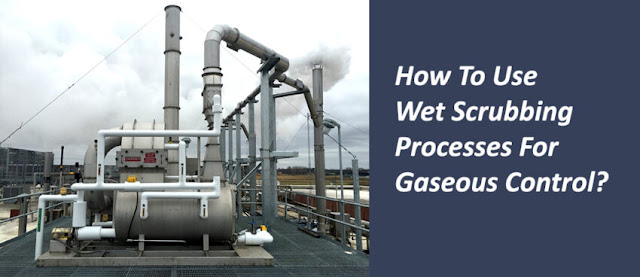How to use wet scrubbing processes for gaseous control?
By using a liquid, Wet Scrubber helps to remove pollutants from an exhaust stream. In the gaseous emission control applications, these scrubbers eliminate pollutants by absorption. Exactly, for this reason, wet scrubbers are designed specifically for gaseous pollutant control which is referred to as absorbers. Yes, absorption is very efficient while monitoring the pollutant gases which are available in the concentration, but also is reasonable for the gases at the dilute concentrations once the gas is soluble in the absorbent. The dynamic absorption force is associated with the soluble gas amount in the solute gas concentration and has streamed in the liquid film in the interaction with the gas.
Wet
scrubbers depend on the large surface area creation of scrubbing liquid which
lets the intimate interaction between the gas and liquid. The large surface
area creation can be skillful bypassing the liquid on a various variety of
media or just by creating a spray of droplets. There are various wet scrubber
designs, that include tray-type, spray tower, as well as packed-bed wet scrubbers and they are commonly
referred to as low-energy scrubbers.
Performance Indicators
Various
Parameters can be utilized as indicators of the performance of wet scrubbers.
The most suitable indicators to control based on different factors that
includes pollutant type, exhaust gas characteristics, and scrubber design.
Pressure differential, scrubber liquid, and liquid flow rate outlet
concentration are the main indicator of performance.
Liquid
Flow Rate
Gas flow
rate basically a frequent based process conditions and it is the major design
that considers the scrubber. The liquid-to-gas ratio is decided and maintained
by the scrubber liquid flow rate. Scrubber liquid flow rate is the main
performance indicator provided the liquid is being distributed properly, and
the liquid-gas interface is properly maintained. Higher liquid flow rates are
actually indicative under these conditions for the higher control levels.
Although for packed-bed scrubbers, there is a serious flow rate upon which
flooding happens.
Gas Flow Rate
Exhaust
gas flow rate actually put a bad impact on the L/G ratio that is a key design
parameter for the wet scrubber. Gas flow is commonly a frequent parameter and
might be controlled to make sure that the flow is within the design range. An
enhancement in the exhaust gas flow rate, without a corresponding, enhance in
the liquid flow rate, might result in a lessening in re L/G ratio that commonly
results in the scrubber control’s decreased efficiency. Fan motor current also
can be controlled as a replacement for exhaust gas flow rate.
Scrubber
Liquid Outlet Concentration
The
scrubber liquid outlet concentration is a tough indicator of gaseous pollutant
removal competence. The increased concentration of pollutants might result in
lower removal efficiency of the pollutant as of enhanced vapors pressure of the
component in the liquid and lowering of the absorption.
For wet
scrubbers used to control acid gas emissions, monitoring scrubber liquid pH is
an adequate surrogate for scrubber liquid outlet concentration.
Pressure Differential
It is one
of the most critical indicators of the performance of the wettest scrubber
designs. Pressure Differential remains constant as well reflects the normal
operation of the gas flow and liquid flow through the system. For packed-bed
scrubbers, bed plugging can result in increased pressure differential, the
increase in pressure in pressure differential can resemble performance
decrease.
Scrubber Liquid pH
Scrubber
liquid pH is acid gas indicator removal efficiency. A drop in the pH can
actually notify that the inlet concentration of gas is enhancing or that
decreased acid is being neutralized. If caustic as other acid counteracting
chemicals are used, and a modification in pH can notify a problem with the
chemical system.
Outlet
Gas Scrubber Temperature
For wet
scrubbers used to monitor the thermal procedures, the scrubber consumes gas
temperature is also a performance indicator. Enhances in the exhaust or outlet
have stream temperature are the operation modification indication. Either the
procedure exhaust temperature has enhanced, or the flow rate gas has increased,
or the liquid flow rate has decreased.
Parameters
to control as an alternative to the liquid scrubber outlet concentration
consists of scrubber liquid pH, scrubber liquid gravity, and scrubber blowdown
rates. For those systems which monitor gaseous stream with less particulate
matter loadings, there is no advantage to controlling the scrubbing liquid
solids content. Clear Ion has the best deal for Wet Scrubber in India and you can get it in different
technical specifications at a very reasonable rate.
Source Url: https://clear-ion.com/blog/how-to-use-wet-scrubbing-processes-for-gaseous-control/




Comments
Post a Comment